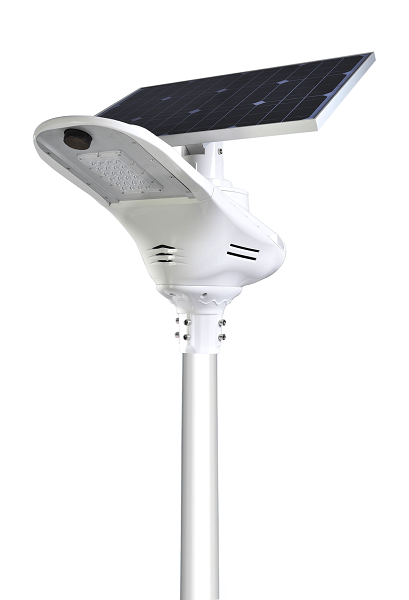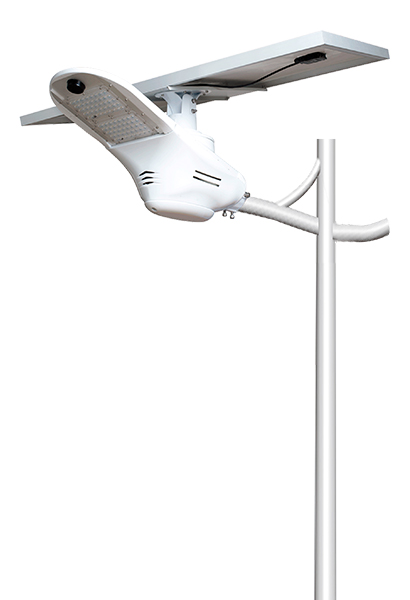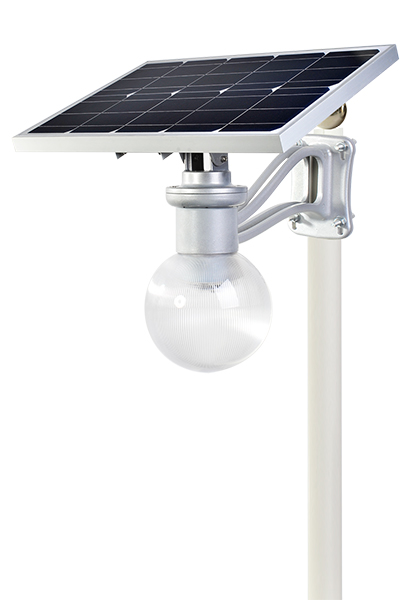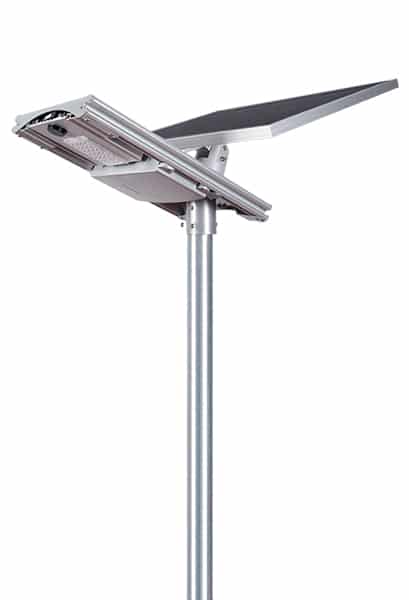Solar LED street light
There’s no argument about it. Solar energy technology has been one of the scarcely untapped resources of renewable energy for centuries. Why is this so? While it is very apparent that you can easily harness the energy from the sun, generation efficiency can barely reach 5-8%. But it gets better each year.
As of 2019, solar street light technology has tremendously leaped globally in applications such as powering up LED street lights, vehicles, corporate buildings, houses, and many other smaller devices.
Solar LED street light is one of the smart technologies ever invented in street lighting systems. It is eco-friendly, cost-effective and presents an unlimited source for the lighting system, as it functions independently without connecting it to the grid.
Solar-powered street lights are designed with an intricate power generation system and energy storage, integrated with style and physical eloquence to deliver the best solar street lights and illumination experience with little to no carbon footprint.
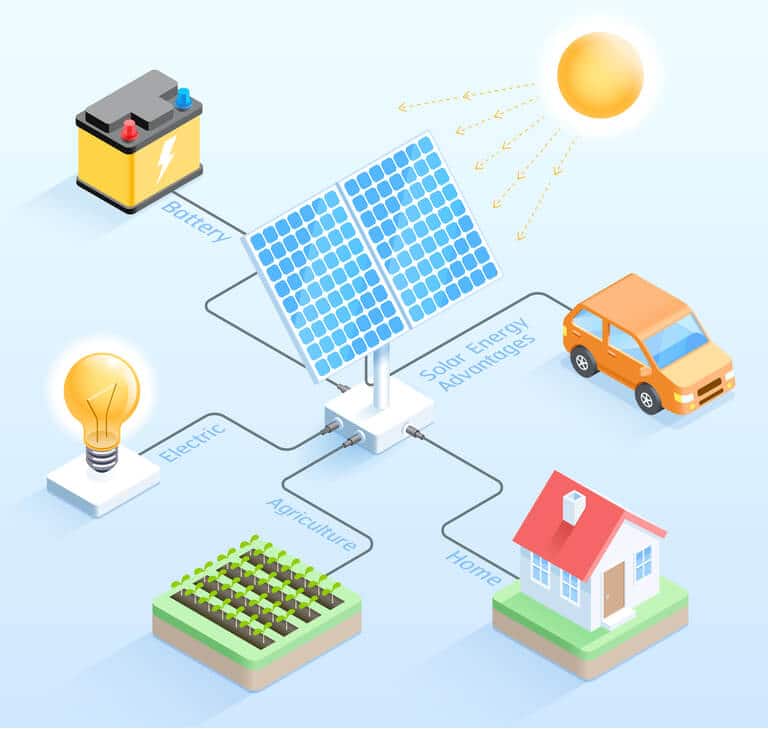
Obluesmart's Innovational Solar Street Lights
Bluesmart Solar LED off-grid, patented lighting solutions range from remote monitored,
time-controlled and customizable all-in-one solar LED street lights to all-in-two solar street lights. We have:
Bluesmart has been a solar street lighting manufacturer and exporter for many years and we have dedicated a large span of our attention in solar street light innovation to help industries and people thrive with clean and eco-friendly lighting systems.
Our latest and most advanced cloud software technology answers your questions on how you can conveniently and efficiently control, maintain and manage each solar street light like simply tapping on the remote control. Our solar street lights can easily be synchronized with a smart-phone, tablet or a computer.
A Brighter Path
Behind the curtain of going solar is a brighter trend towards the next eco-friendly generation. Many countries today have been investing more and more in greener alternatives. Currently, solar lighting technology has been highlighted in many infrastructure exploits than ever before.
We can see the trend more perceptible for small-scale projects, where businesses and institutions can benefit from its cost-effectiveness. Bloomberg forecasted that by the end of 2040, solar LED street lights will increase to 34% of the world energy consumption. That means, we’ll be seeing more of solar street lighting in the future.


In succeeding sections, we will go through the basics on what solar lighting is all about and review how each component works together.
Lastly, we will examine the aspects on what you and your potential prospects must look into when choosing a smart solar street light manufacturer. This, in turn, will let the manufacturer know what you and your client need.
What is a Solar Street Light?
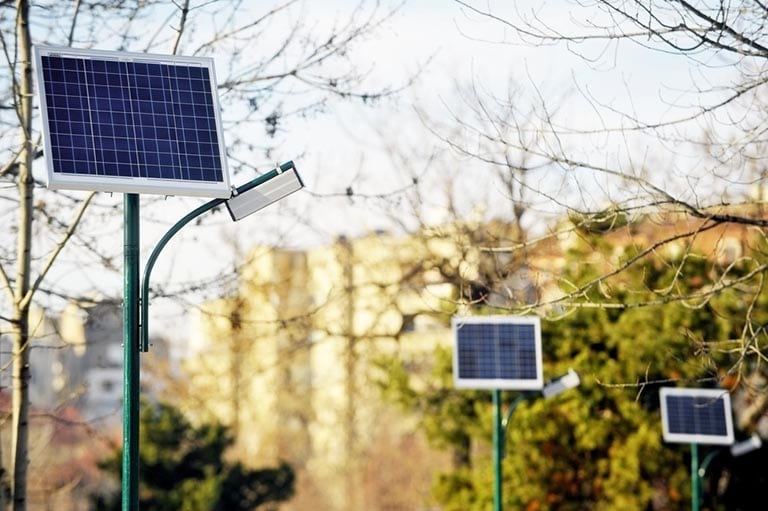
Solar street light is a state-of-the-art invention and an advanced system of lighting that is used for either indoor or outdoor lighting applications. As compared with traditional street lights, solar LED street lights are powered by the sun and is the future of solar-powered street lighting. In many countries, you can find these trendy and environmental street lights around corporate buildings, houses, parks, and secluded areas.
What are the Components of Solar LED Street Lights?
Solar LED street lights are composed of a number of major components. The quality of the components and the technology incorporated in the street light system determines the overall performance of the LED street light.
For Bluesmart, all components are designed with modularity and with a protection class of up to IP65. The lamp shell is designed of high strength, weather-resistant and high precision die-casting aluminum material. Plus, fasteners are furnished with stainless steel anti-theft design to ensure safety and robustness even in outdoor conditions.
Choosing the right solar LED street light type can be a difficult task so you need to determine several system design issues that may occur. You may discuss this together with your technical team and solar street light manufacturer.
SOLAR STREET LIGHT COMPONENTS:
#1 Solar Panels
A photovoltaic solar panel absorbs the sun’s light rays and transforms it as energy to generate electricity. There are two general types of solar panels widely used in solar-powered street lights technologies: Monocrystalline solar panel and polycrystalline solar panel.
In general, monocrystalline has a better reputation in capturing solar energy than polycrystalline, more predominantly in cold weather. With better manufacturing process from Sunpower technologies, it can even reach as high as 24.1% power conversion rate.
Bluesmart solar street lights are manufactured with monocrystalline solar panels, giving you the optimum energy collecting capability even with its small size. The monocrystalline solar panel is attached to the pole and acts as a medium that harnesses solar energy during the daytime then transforms it to electric power stored in the battery to be used during the night time.
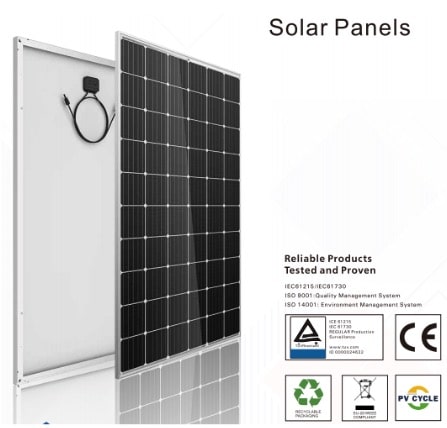
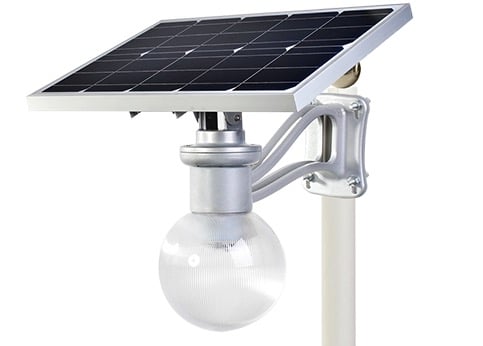
#2 LED Light
LED is used for the lighting component of solar street lights. Smart solar LED lighting is the most energy-efficient method of lighting which produces higher Lumens per wattage.
This means that using LED as lighting source can cut costs by at least half. LED lights also provide higher luminous of intensity than traditional lighting with no UV emissions.
Another benefit of using LED lighting is its longer working hours than traditional street lights. While LED can last over 50,000 hours, regular street lights has can only last 5,000 to 8,000 hours.
#3 Solar Rechargeable Battery
Solar LED street lights are equipped with rechargeable batteries. A solar rechargeable battery is designed to capture solar power during the daytime and use that power to light up the street at night. Newer and more enhanced battery designs employ nano photocatalysts for storing solar energy which is directed to achieve clean charging.
Still, almost all renewable solar-powered systems use deep-cycle batteries designed to provide a continuous pulse of current for longer periods of time than that of a car’s battery. Deep-cycle batteries can also be more reliable than car batteries in terms of cycle time as it can discharge currents from time to time without deteriorating its capabilities.
Lead-acid battery and Lithium battery are two of the most common deep-cycle batteries used in the solar LED street lighting technology.
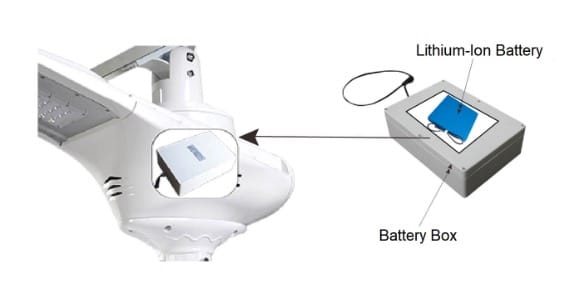
Why All-in-One Solar Street Light manufacturers prefer lithium-ion batteries
- Maintenance is required more when using flooded lead-acid batteries.
- Even if sealed lead acid batteries require less maintenance, they are more costly than flooded batteries.
- Other lead-acid battery types are bulkier and require more space in all in one solar street lights.
- Lithium batteries are tested to have a longer service life that lead-acid batteries having 6 times the number of cycles.
- Lithium-ion batteries can withstand occasional discharging more than lead-acid batteries.
Ternary Vs. Lithium Iron Phosphate Battery
There are two types of Lithium-ion batteries that manufacturers use for all-in-one solar street lights:
Which Lithium-ion is better?
Given the comparison above, it is apparent that Ternary Lithium is lower in cost but cannot work in low temperature areas. Lithium iron phosphate has a wider range of areas in the world as it can work in low to high temperatures.
For safer reasons, LiFePO4 is recommended for all solar lighting applications. You can use ternary lithium batteries if you and your clients are in a tropical area but the risk for battery explosion is high.
| Ternary Lithium Battery | Lithium Iron Phosphate (LiFePO4) Battery | |
|---|---|---|
| Size | 18 x 65 mm | 26 x 65 mm |
| Nominal Voltage | 3.7V | 3.2V |
| Voltage of Battery Set | 12V | 12.8V |
| Cost | Cheaper in price | More expensive |
| Working temperature | -30 to 65 Celsius | -10 to 75 Celsius |
| Cycle Life | 1500 times | 1200 times |
#4 Smart Solar Controller & Communication
The solar charge controller is an essential device in solar-powered street lights. It is used in regulating the voltage and current to prevent batteries from overcharging. Solar charge controller is situated between the solar panel and battery to control and manage the amount of voltage and current coming from the panels.
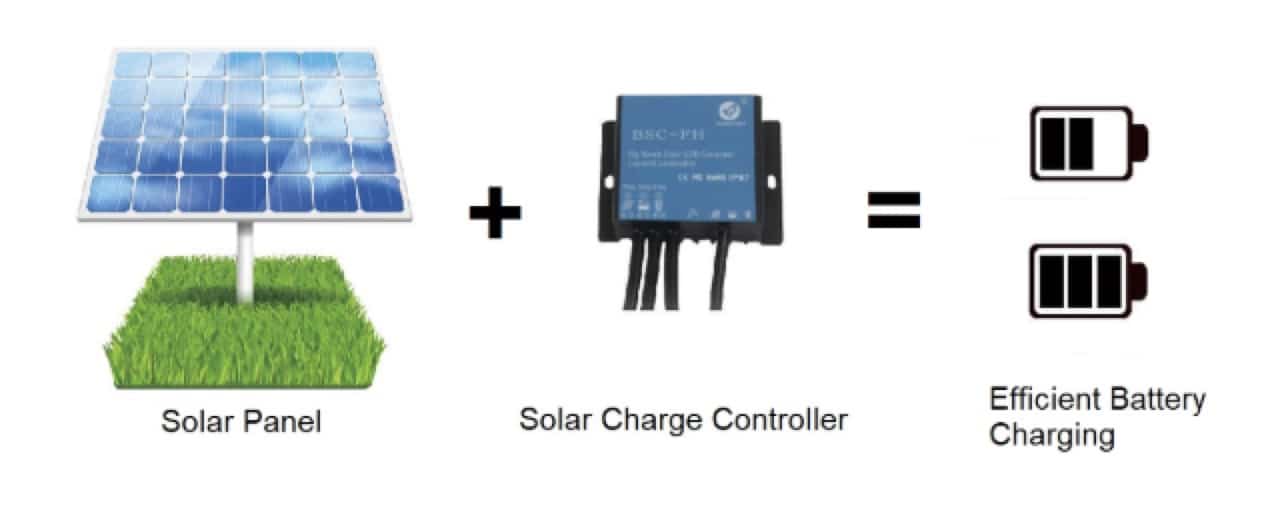
Solar charge controllers are often used in solar hybrid power systems but not in grid-tied solar power systems as they are not equipped with a rechargeable battery.
How it works
When the solar charge controller detects no energy input in the solar panels, it opens the circuit to disconnect them from the lithium-ion batteries. Solar charge controllers act like check valves which prevent reverse current flows and maintains unidirectional streams.
When evening comes and it’s time for the solar LED street light to work, the panel voltage is kept below the batteries’ voltage, ensuring safety and efficiency.
In summary, solar charge controller is used to:
- Prevent battery overcharging
- Prevent reverse currents
Overheating can be a direct result of overcharging which might result in fire hazards. When deep-cycle flooded batteries are overcharged, it can give off unpleasant gasses such as hydrogen. Furthermore, overcharging can cause a defect for the solar battery and reduce its service life.
When you look more closely at a quality-made solar charge controller, you can see that it contains complete components such as the low-voltage disconnect, remote monitoring device, load control feature and sensor for temperature and compensation.
MPPT vs PWM Solar Controllers
In solar technology systems, there are two common types of controllers used: PWM and MPPT. Most All-in-one solar LED street lights adopts the MPPT charge controller than the PWM. MPPT is the best solar charge controller and the most up-to-date.
One of the main advantages of using Bluesmart Solar LED street light is its controller uses MPPT technology, which automatically adjusts the power output with changing weather conditions.This ultimately gives 16% to 30% charging efficiency.
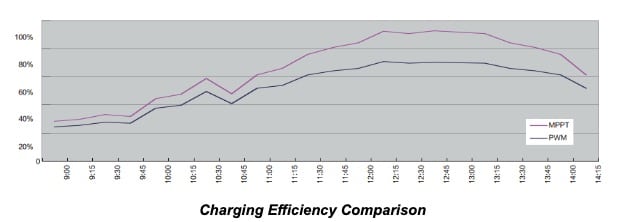
As the main functional component, MPPT solar charge controllers have some basic functions as below:
1. Dusk to dawn control
The MPPT controller has complete surveillance on the solar panel voltage. Usually when dusk is about to come, the voltage would decrease to 5V which signals the LED light to switch on. At dawn, the voltage increases more than 5V which signals the LED light to automatically turn off.
2. Time control
There is also a time control option for the MPPT solar charge controller which can manipulate the power output according to a time table.
- 70 percent brightness from 6:00 pm to 7:00 pm,
- 100 percent from 8:00pm to 10:00pm,
- 30 percent from 11:00 pm to 5:00 am.
Plus, the time control system works with the motion sensor to also control the power output. For instance:
11:00pm to 5:00am - # of people - Few - 30% power
People detection signals the motion sensor to automatically increase to 100% power so that the person can see clearly.
This off-grid smart technology is an economic way to reduce energy consumption from the batteries and allows a smaller carbon footprint.
3. Motion sensor control
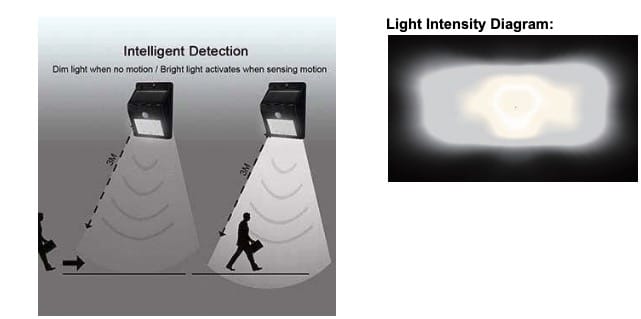
A smart street light has a motion sensor control that allows the LED light to only increase in brightness upon detection of a passer-by. It will automatically decrease in brightness when there is no one around.
4. Preventing overcharge and Low voltage disconnect(LVD)
Batteries can be affected negatively when you overcharge it. The same thing is true when it over discharges power. Controllers prevent these circumstances by monitoring low voltage and overcharge.
#5 Remote Management Software (RMS)
Remote management software promotes proactive surveillance of light performance to ensure cost-effectiveness of the equipment and prevent maintenance issues. It also provides monitored reports of the solar lighting system’s operating status.
With the RMS system, lighting intensity and performance is monitored well. You can even set your own lighting timetable with dimming schedules, motion sensor and input other lighting preferences.
#6 Motion Sensor
Microwave Motion sensor
There are two types of motion sensors commonly used in solar-powered LED street lights. These are the microwave and infrared motion sensor. While the infrared motion sensor receives heat source from objects/people moving, microwave sensors send and receive bounced signals.
Bluesmart All in One Solar LED street light uses a microwave motion sensor that has a flexible working angle of 120 degrees which can easily detect motion through a cone-shaped space covered by the light.
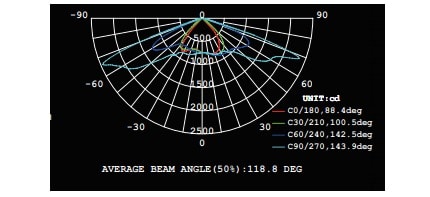
Although microwave sensors have a larger scope of detection capabilities, its sensitivity is a major nuance. To eliminate sensitive inefficient tendencies of the microwave sensor, we have developed the product to respond with a dim light for over 5 meters of distance and with a full brightness for less than 5m of detection.
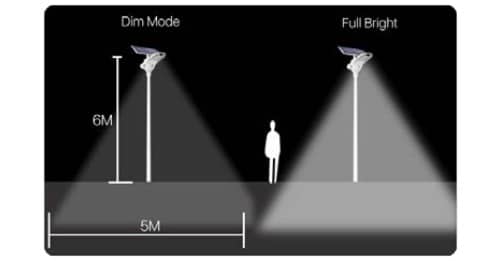
#7 Interconnecting Cables and Wireless Connection
Some other smart features of Bluesmart’s All in one solar street light is its integration of interconnecting cables such as Bluetooth equipment, CCTV(Closed Circuit TV), or even wireless monitoring system. This permits users to conveniently monitor and control each light through their phone, PC or tablet anywhere and anytime.
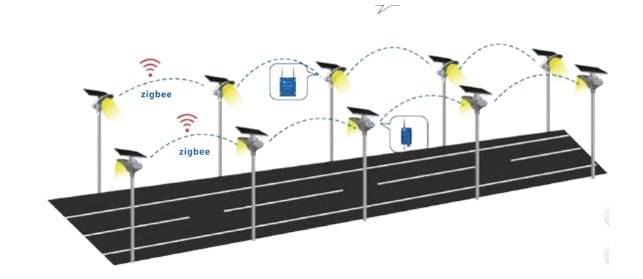
You can do the following operations:
Lighting control
Automatically control the on/off operation and illuminating brightness control.
Historical data
Monitor capacity generation per day, internal temperature and detailed charging data.
Working mode
You can easily customize the working mode of the street lights according to your specifications.
State monitor
Real-time monitor every part at their normal working condition, such as battery consumption, load power, temperature, surplus electricity consumption.
#8 Mounting Pole
The mounting pole holds all the components of the solar street lights. It contains the solar panel, controller, battery and other fixtures.
Since it holds all the necessary equipment to store and produces electrical energy from the sun, it should be designed to hold the weight load of everything plus the wind load. Different countries have different wind pressures. The strength to which the pole must withstand should have a suitable factor of safety to combat the most severe weather conditions.
Application of Solar LED Street Lights
Are you looking for a green alternative?
Solar-powered street lights provide a green alternative when compared with traditional street lighting. It does not emit greenhouse gases and are self-sufficient. If your company is looking for a greener alternative to street lighting and at the same time, lower your bills, solar-powered street lights are a good way to go.
Here are some applications of solar-powered street lights.
1. Roadways
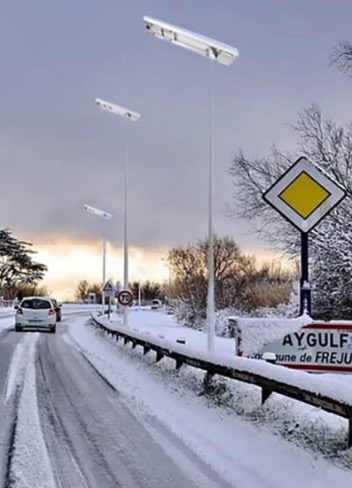
Solar LED street lights can be used in roadways and alleys, huge lanes and motorways.
Since roadways may present several vehicles traffics, a narrow beam angle is required across the pavement road and a wider beam angle along the road. This is to efficiently distribute the street lights with lesser number of poles required.
Solar street lights are essential for people at night for safety purposes and prevention of anomalies or crimes. Plus, they are more affordable than traditional streetlights. Street lights are also beneficial for pedestrian lanes and for bikers’ lanes to prevent accidents especially during night time.
What’s more is with each solar-powered LED street light shows awareness for greener alternatives for the betterment of the environment.
RECOMMEND for Roadway Lighting: Fly Egret Series
It has a mounting height of 4-10 meters depending on what clients need. This bridgelux LED solar street light has 15 to 20 meters perimeter detection distance suitable for detection of passing cars along the road.
2. Parking lots lighting, playgrounds, public squares, airports and other open spaces
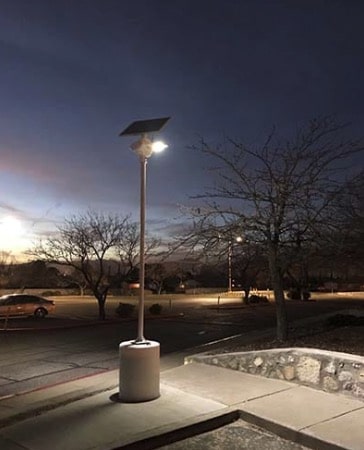
Outdoor fixtures and lighting is essential for common open areas such as big parking lots, airport spaces and outdoor security. These are public areas which are prone to accident causes without proper illumination, especially at night.
Serbia is one of the first few countries that invested in green initiatives and today, their public areas are illuminated with solar powered street lights. This has reduced a bulk of cost for public facility improvement as extra trenching and extra cabling are not necessary.
Bluesmart carries self- sufficient solar lighting systems, all in one and all in two LED street lights ideal for all lighting scenarios for public areas such as residential spaces, villages, public parking lots, avenues, playgrounds and urban areas.
RECOMMENDED for Open Area Lighting: Moon Light Series
Moon Light is Bluesmart's innovative solar powered garden light. It charges in 6 to 8 hours and lasts all night. Installation is easily done through wall mount or pole. It has a high LED output which is perfect for illuminating open space areas.
3. Site Perimeter
Most often than not, factory and building perimeters, industrial zones and powerplant zones need a strong source of light. These areas commonly work for 24 hours and a lot of activities such as maintenance, perimeter checks and loading and unloading are carried out. Solar LED street lights can help lower down expenses for investing in perimeter lighting.
RECOMMENDED Solar Lighting for Site perimeter: FP Series
4. Government

Solar street lights compared with regular street lights aid in environmental conservation. These environmentally-friendly lighting solutions also helps the government lower down expenses on utility costs for outdoor lighting. It also helps in preventing crimes at night.
It is forecasted that by 2026, 359 million lights would occupy the world whereas at present, we only have 315 million.
The future of solar LED street lights will undoubtedly grow as we are currently shifting in greener alternatives. This global trend will invoke government entities to install solar street lights instead of restorting to regular street lights because of its lower cost, eco-friendly solution and lower energy consumption.
Plus, it adds up that solar LED street lights are one of the best and most reliable options in areas where it is costly to invest in AC power solutions.
TOP RECOMMEND for Government Lighting: Fly Hawk Series
The Fly hawk series is Bluesmart's flagship model, tailor made for government solar street lighting projects. It features all of its components fully integrated within an attractive and compact design, combines a highly efficient adjustable solar panel with smart controller to energize high capacity LiFePO4 battery that suppliers power to the Super-Bright Bridgelux LEDs.
6. Corporations
Anywhere in the world, corporations are trying to help society through green initiatives. These initiatives can be through planting more trees around town and reducing carbon footprints in offices. With this, solar LED street lights can dramatically reduce energy consumption as it is installed off-grid. Companies can look into its astounding benefits and can bring their investment to the next level for solar LED lighting systems.
What’s more is that corporations can benefit through state incentives that can help minimize capital expenditures.
RECOMMENDED: Swan Series
The SWAN series is Bluesmart's 2017 newest design patented product, especially created for horizontal installation on single arm or double arm street poles.
7. Schools and Universities
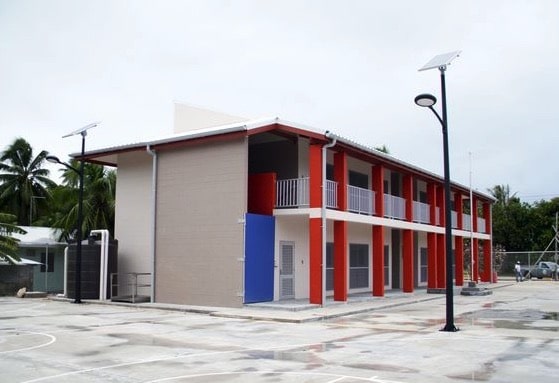
Schools and universities need reliable lighting. Areas where universities are located are filled with dormitories, bus stops, parking lots and study areas would take a lot of street lights to fill an the investment for this can be dizzying. Thankfully, solar powered street lights can be your practical solution for a cost effective and reliable source of illumination.
Solar powered LED street lights creates green behavior through its energy efficient outcomes. It also invokes a sense of awareness toward school personnel and students to support green initiatives.
Benefits of Solar Powered Street Lights
Security
Smart illumination can promote safety and security in premises and properties. Even assets can be protected as lighting promotes transparency of activities whether they pose potential threats or not.
In military scenarios, solar street lighting systems help soldiers when grid-powered systems are not available. Smart lighting technologies aid in combat, defense and enemy attacks.
Savings
The sun is an unlimited resource of energy and is a renewable energy source. With Solar powered street lights, the sun’s energy can be harnessed and used to power up street lights. Low maintenance cost and easy installation are major benefits of solar street lights in the long run.
Sustainability
As we shift towards renewable resources, solar street lights leads the path to a sustainable future. Solar-powered LED lighting reduces carbon footprint and promotes autonomy from the grid.
Economical
Bluesmart manufacturers solar LED street lights with the latest technologies and electronic components to create high quality and less expensive lighting system. Our company offers support and assistance to you when choosing a suitable solar street light for your application.
With a full proof illumination and lighting plan, your company can save a large sum of money for many years. Our in-house lighting designers can survey your area and help you choose the best lighting option.
Technologies Involved in Solar Lighting
1. New Tech for Energy Storage - LiFePO4 Batteries
LED solar lights use rechargeable batteries with differences in life cycles. It is essential to use a new and improved battery technology as this component will have a tremendous effect on the solar street light’s performance. Also, the backup days of LED light is affected by the battery’s capacity.
There are lithium batteries and lead acid batteries in existence for solar lighting technology. Lithium batteries are widely used today as it is lighter, more compact and has a longer lifespan. It also has a larger depth of discharge. The most important aspect of lithium batteries is that they have larger capacities than lead acid batteries.
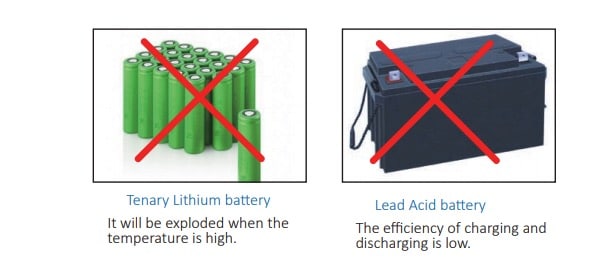
2. New Tech for Solar Lighting - High Luminous LED Lighting
LED lighting is globally popular for its impressive performance and eco-friendly capability. It has exhibited the fastest and most reliable growth compared with all lighting technologies.
Installation, Operation and Maintenance of Solar Street Lights
Installation
Installation of solar street light is very simple, guaranteed that you don’t need an engineering background. The wiring process is not very complex as well. You will just need to fix 12 screws to fasten the street light to its components.
The installation procedure can be summarized with this: You will need to fix the multi-angle bracket on the solar panel first, before mating it with the rotating platform assembly. This is to ensure that the fixture is secure and installed at its proper orientation before installing the pole.
What components you will find in the package?
- Solar Panel
- Motion Sensor
- LED Light
- Vents
- Bracket Support
- Smart Controller
- Monitor
- Rotating Platform
- Multi-angle bracket buckles
- S-bracket - for fixing the light unit
- Maintenance channel
- Screws: M6x20, M6x12, M8x100, M8x30, M10x25 - approximately 12 to 22pcs
- Allen keys
- Remote Control
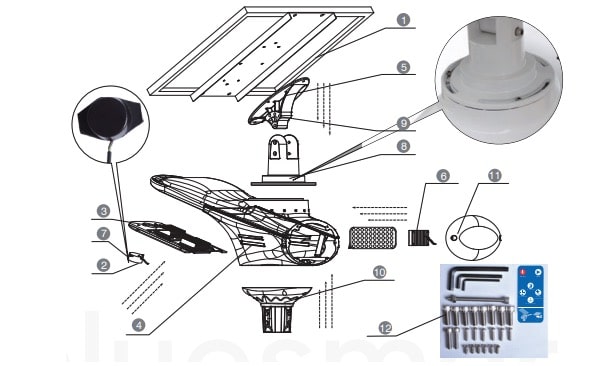
Here’s a comprehensive step-by-step procedural excerpt from Bluesmart Flyhawk Installation Guide on how you can properly install a solar street light:
#1 Installing the Bracket Support
Secure the multi-angle bracket buckles on the solar panel with M6x20 screws.
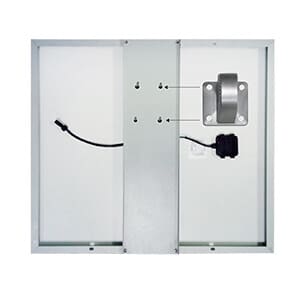
#2 Fastening the Rotating Platform
Examine the orientation of the road before securing the light body to the rotating platform. You would use M6x12 screws for this procedure. Install it according to the picture below.
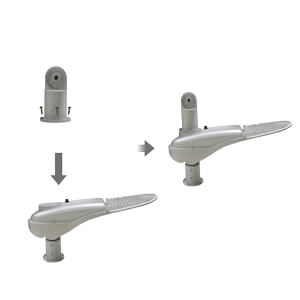
#3 Fastening the Bracket Support Assembly from #1 to the Rotating Platform Assembly in #2
You would use M8x30 screws and a set of M8x100 screw to fix the multi-angle bracket buckles. Make sure to locate and secure the proper holes of the two assemblies before fastening the screws.
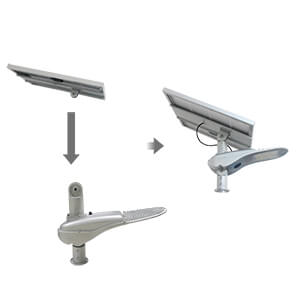
Note: Follow the installation position of the sun at 2:00pm. Make sure the solar panel is headed toward the sky and the short end toward the light, or you can not adjust the angle.
#4 Installing the Light Assembly to the Pole
Secure the light unit to the pole with 8pcs M10X25 screws.
The maximum torque for installing the light is: 29Nm (M10X25 bolts). You would want to use a torque wrench to exact this. Do not surpass this torque specification.
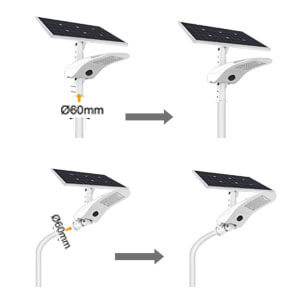
Operation and Maintenance
Solar street lights operations and maintenance (O&M) packages are available as protection plans for your investment. If your street light component is somehow malfunctioning, for instance as a result of environmental reasons, your O&M solar street light provider can look into the matter and perform repairs. Solar operations and maintenance plans can also cover regular maintenance checks and performance checks.
All-in-One Solar LED Street Lights VS. Traditional Solar Street Lights
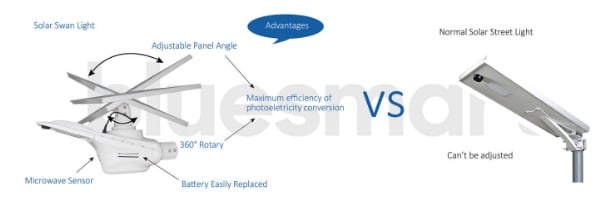
If you want to know the difference between traditional street lights and all-in-one solar street lights so you can decide on which to buy, here is a comprehensive comparison between the two.
| / | / | Traditional solar street lights | All in one solar LED street lights |
|---|---|---|---|
| Basic | Light source | MH (Metal Halide) | LED (Bluesmart uses Bridgelux) |
| Energy saving | no | yes | |
| Installation | Grid dependence | grid-tied | off-grid |
| Interconnecting Cables | With cables | No cables | |
| Technical skills on wiring | yes | no | |
| Performance | Autonomy days | 3 days | 3 days |
| brightness | 3000 lumens | 3000 lumens | |
| Power consumption | 50 watts | 17 watts | |
| light efficiency | 60 lumens / watts | 180 lumens / watts | |
| working hours | 10 hours per day | 10 hours per day | |
| battery type | sealed lead-acid | lithium-ion | |
| battery size | 156 Ah | 27 Ah | |
| solar panel size | 280 watts | 50 watts |
Let’s Talk About Cost
In this section, we will be dealing with solar street light costs: a major deciding factor for many clients. While solar street lights do present higher upfront cost than traditional street lights, maintenance and operation costs are much lower.
Whether you are installing a new solar street light or converting old street lights to solar, electricity bill payment is eliminated. Plus, you don’t have to worry about blackouts as the solar street lights are sun-powered.
While it is true that traditional street light has a lower cost per unit in the initial purchase, you would have to sum up operation and maintenance costs over time which makes it more expensive in the long-run.
Cost Comparison Between Traditional Street Light and All-in-One Solar Street Light
| / | Traditional Street Light Cost | All-in-One Solar Street Light Cost |
|---|---|---|
| Light | $1,500.00 | $3,000.00 |
| Installation | $4,500.00 | $1,500.00 |
| Maintenance for 10 years | $800 | $1,000 |
| Energy | $1,500 | - |
| Total Cost for 10 Years | $8,300 | $5,500 |
The Price of Traditional vs. Solar Street Light Installation
If we are talking about installation fees, there’s a big difference between regular and solar street lights. In the table above, we it presents an average of $3000 difference. This accounts for labor cost for trenching, wiring and installation for traditional street lights that is not needed for installing all-in-one street lights.
Additional costs are also involved when a traditional light needs to be connected to the grid as it is dependent on electricity.
For All-in-one solar street lights, you won’t need work-intensive job for installations. Solar street lights present autonomy from the grid so there is not much cost involved in installation.
Maintenance Cost with LED Light
When we talk about maintenance costs for solar street lights, it might be more costly as compared with traditional street lights.
While this might be a deterrent factor for clients, solar street lights do present less maintenance than regular grid-tied lights. This is because the LED light have 5-7 years of life while MH lights have only 200-333 days, which is less than a year. This means that it would be more often to replace the light for traditional lights than in solar LED street lights.
Moreover, the battery requires to be changed every 5 to 7 years. For this, you would be spending around $1000.
Energy Costs
Traditional street lights are connected to the grid so electricity bills are accounted for its cost every year; whereas for solar street lights, it only uses the energy from the sun which is practically free.
Frequently Asked Questions (FAQs)
Can Electrical street light be converted to solar powered street light?
The answer can be yes or no. In this case, the lighting system would have to be replaced so that it can generate the sun’s power. You may, however, use the street light post again.
Can you attach a solar panel to a traditional street light to run as a solar street light?
The traditional street light is designed for electrical AC power to accommodate the power source from the grid. It needs to be equipped with a low DC-powered equipment, which is the battery. The battery is responsible for storing the energy from the sun that is harnessed by a solar panel.
While this may be possible, it is not an economic decision to make and it’s better to just buy a new solar street light than try to convert regular street lights.
There may, however, be a case where you can convert a traditional street light to run solar. You would need to consult the solar street light manufacturer to get an advice.
Can the pole be reused?
The short answer is it can be possible. This depends on the wind loading capacity of the pole. As a solar street light weighs more than the traditional street light because of the solar panel, controller and battery, the existing pole might not be able to withstand this load. It would also depend on the wind pressure in your area.
What’s Next?
Solar-powered street lights are a great green alternative for traditional lights which presents off-grid and cost effective solutions for the future of street lighting. With All-in-one solar LED street lights, an integrated system for lighting, charging, and energy storage with remote monitoring and control is facilitated with this smart technology.
If you need further assistance with your street lighting design and choice, feel free to explore our website for more solar lighting options. You may also contact us for more information and solar lighting quotation.

